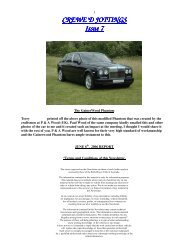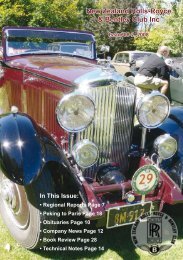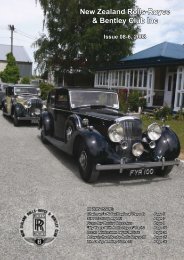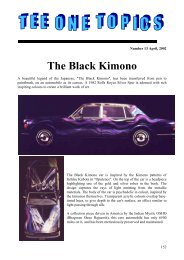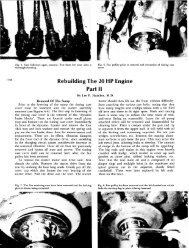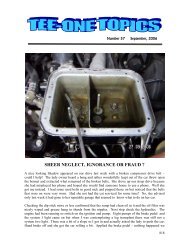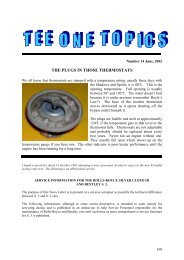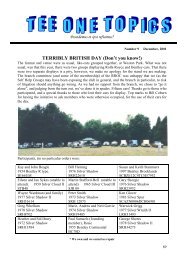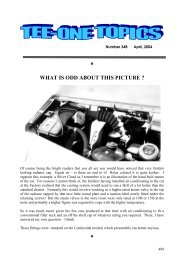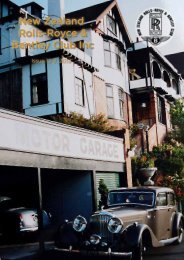April 2012 Newsletter - KDA132
April 2012 Newsletter - KDA132
April 2012 Newsletter - KDA132
You also want an ePaper? Increase the reach of your titles
YUMPU automatically turns print PDFs into web optimized ePapers that Google loves.
HUNT FOR THE BLOWER BENTLEY<br />
By Kevin Gosselin<br />
Published by MX Publishing 2011<br />
335 Princess Park Manor, Royal Drive,<br />
London N11 3GX<br />
Paperback 21.5cm by 14cm 311 pages<br />
ISBN 978-1-78092-018-4 £12.99 also<br />
available from amazon.com<br />
The supercharged 4½ litre Bentley has<br />
induced varied emotions since it was first<br />
introduced, in 1929. W.O. Bentley was<br />
highly critical of it, writing in My Life and<br />
My Cars (Hutchinson, London, 1967) “To<br />
super-charge a Bentley engine was to pervert<br />
its design and corrupt its performance…Of course we were after<br />
speed and acceleration, but not by any falsely induced means; and<br />
I always held that the supercharger applied to a Bentley engine<br />
was, by its nature, a false inducer.”<br />
The supercharged Bentley came about because one of the most<br />
archetypical of the “Bentley Boys,” Capt Sir H.R.S. (“Tim”)<br />
Birkin, Bart (1896-1933), saw supercharging as the way to racing<br />
glory for Britain, Bentley, and Self, not necessarily in that order.<br />
He persuaded Amherst Villiers to design a special supercharger<br />
for the 4 ½ litre engine; Managing Director of Bentley Motors,<br />
Capt Woolf Barnato, to approve it; and The Hon. Dorothy Paget<br />
to finance a workshop and the purchasing of the raw materials<br />
to modify and build a team of racing cars. Barnato was then<br />
persuaded to let Birkin enter a team in the 1929 Le Mans 24<br />
Hour Race, but the snag was that, for the entry to be valid, 50<br />
supercharged cars had to be built for sale to customers. These<br />
were delivered between October 1929 and some time in 1933, as<br />
well as 5 racing cars for Birkin and his fellow Bentley Boy, the<br />
Australian Bernard Rubin. When asked why his company went<br />
broke, Bentley usually gave three reasons: the Great Depression,<br />
the 4 litre, and the “blower 4½s” in proportions of about 70, 20,<br />
and 10% respectively.<br />
Since they were built, those 55 supercharged cars have achieved<br />
a mana which far exceeds the other 3,000 “W.O.” chassis built at<br />
Cricklewood, helped no doubt by the author Ian Fleming’s choice<br />
for his hero Commander J. Bond, to drive.<br />
So, what has happened to those 55 cars? Could a previously<br />
lost supercharged Bentley be found? This is where our book for<br />
review comes in. Its hero, Faston Hanks, is an urbane American<br />
Book Review<br />
Company News<br />
who seems able to move in British society as easily as Fred Astaire.<br />
He is on the trail of the only car unaccounted for, chassis SM3912,<br />
a drop-head coupé by the coachbuilder Phillips, originally owned<br />
by The Lord Brougham and Vaux.<br />
There is an idea for a ripping good yarn there somewhere, but<br />
this book isn’t it. It would perhaps succeed in the Young Adult<br />
category, for, apart from some gratuitous violence, there is no sex,<br />
and no naughty words, but for anyone interested in old Bentleys<br />
and their provenance more has to be expected.<br />
Our handsome wind-blown hero Faston Hanks has apparently<br />
had some success already in tracing cars and their pedigrees, and<br />
perhaps we should have read those books first, so that characters<br />
who appear in “Hunt For the Blower Bentley” without even an<br />
introduction to provide a shred of character sketching would mean<br />
something. We have a Charles and a Patrick, foisted upon us in<br />
the present tense, and, to keep us on our toes, events of 1939 are<br />
superimposed.<br />
The author’s choice of names for his characters is a bit bizarre:<br />
how about Blaine de Badenet for a car expert? There is a real person<br />
named Alain De Cadenet, Philatelist to H.M. Queen Elizabeth,<br />
vintage and modern racing driver, Spitfire pilot, and driving force<br />
behind his eponymous Le Mans racing car, which finished 3 rd in<br />
1976. One wonders how he feels about a disguise as thin as a false<br />
moustache. Your reviewer cannot help but remember the story<br />
of the Kiwi racing mechanic who helped with the Le Mans car,<br />
and Mr de Cadenet’s wife (known only as “Biggies” for two very<br />
good reasons) who realised that the chaps were working in the<br />
mews garage beneath their London home around the clock with no<br />
sustenance. Her catering skills ran to ordering a round of Stilton<br />
cheese from Fortnum and Masons which the mechanics had to<br />
attack with their oily hands and tools.<br />
For a book published in Britain there seems to be no attempt to<br />
use nomenclature familiar to those who have enjoyed Bentleys,<br />
(“fenders”?) but your reviewer will refrain (with difficulty) from<br />
railing against the American spelling which is so hard to avoid.<br />
It is all too easy to take cheap shots at Gosselin, “a Porsche racer<br />
who loves finding hidden cars” according to the book’s blurb. The<br />
Bentley Drivers Club experts are invoked, but just how possible<br />
is it to build a new supercharged Bentley from scratch, and to a<br />
standard likely to convince them?<br />
The review copy, now in the Club Library, was provided by MX<br />
Publishing<br />
A.T.K.<br />
Bentley Motors’ images of (left) the ex-Birkin supercharged 4½ litre, chassis HB3403, en route to the Mille Miglia celebrations and<br />
(right) R Type Continental, chassis BC14C, followed by the new 6 litre W12 Coupé<br />
W.O. Bentley’s gift for creating cars that combined the speed of<br />
a thoroughbred racing machine with an enviable reputation for<br />
strength and comfort, allowing them to effortlessly cover hundreds<br />
of miles, is set to be underlined once again at the <strong>2012</strong> Mille Miglia<br />
when two 4½ litre Bentley Blowers take on the classic 1,000 mile<br />
endurance test.<br />
Despite having a combined age of over 160 years, the Bentley<br />
Blowers are showing no signs of slowing down. The 4½ litre<br />
Supercharged ‘Birkin Blower’ – raced extensively by the legendary<br />
Le Mans winner and Bentley Boy Tim Birkin – has already<br />
successfully completed the Mille Miglia in 2005 and 2011.<br />
The Birkin’s companion car is one of 50 Blowers built for road<br />
use and still appears at Bentley events around the world. It started<br />
life in 1930 as one of the company’s first showroom demonstrators<br />
and is still performing its fair share of ‘test drives’ eight decades<br />
later. Rolf Frech, Bentley’s Member of the Board for Engineering,<br />
who is leading the Bentley team at the Mille Miglia comments:<br />
“It is a privilege for the team to drive these remarkable cars at<br />
the Mille Miglia as they embody so many of the qualities that set<br />
Bentley apart from other marques and W.O. Bentley’s brilliance as<br />
NZRR&BC Issue 12-4 17



